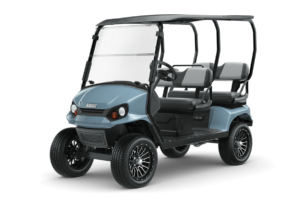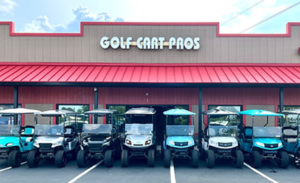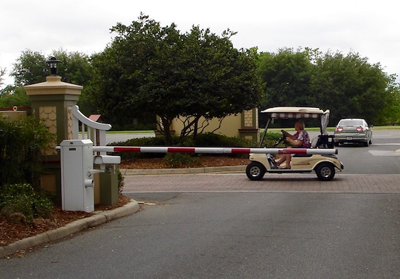What Golf Car-Type (GCT) Vehicles Should Choose as a Consumer (or a Dealer for that Matter)
With the market for golf car-type (GCT) vehicles is in flux and with many new entrants in the market, both dealers and consumers are having to make choices based on an extensive mix of important variables. It is no longer simply choosing between one of the three established brands, Club Car, E-Z-GO, and Yamaha—undoubtedly good choices for many—because there are now multiple new brands available.
As a buyer or a dealer it would be useful to create a checklist of things that could help guide the choice of vehicle. Not surprisingly that while the items on the respective lists may differ, some of the most important are very much the same. Here are some those similar pairs:
Similar concerns when choosing a brand
In choosing a brand (the OEM supplier) both consumer and dealer should investigate:
• The vehicle models that an OEM makes and what attributes are standard options, which are included in the MSRP;
• Parts availability;
• ervice and repair capability;
For the consumer these questions are pertinent, but for the most part he or she must depend on the dealer for the answers. Happily, the dealer is also interested in establishing or maintaining a good reputation and expanding the market for the dealership. So, positive assurances from the OEM are also critical for the dealer.
Choosing the right vehicle
Choosing the right vehicle may seem to be a straightforward matter of taste and budget. The marketplace is now changing, however, The old golf “cart” is now taking to public roads in growing numbers and is becoming a viable alternative to conventional automobiles for short distance driving purposes—whether it be for grocery shopping at the local Publix (Florida) or cruising around the neighborhood to keep in tough with friends and family.
If you will be using your GCT vehicle for the above purposes, or anticipate doing so, and you don’t do much golfing, then you will probably be looking at quite a different vehicle than if the opposite were true (a lot of golf, not much use on public roads)
Given the variety of models now available at dealerships, the question of primary use will probably be one of the first questions the dealer will pose to you, the consumer/customer.
LSV vs. PTV: Which one should I buy?
In general the official designation of Low-Speed Vehicle, or LSV, means that the vehicle is certified as “street legal”. Certain specifications have been met and a VIN number has been issued. A widely recognized limitation on public road use is that the roads have a speed limit of 35 mph or less, but there could well be, and most of the time are, local traffic regulations in force. These regulations can be very restrictive or quite libera–tolerant to the point that PTVs may, in fact, also be allowed on public streets in certain areas.

As a rundown or summary of the differences between an LSV and a PTV, let’s use the following table taken from E-Z-GO’s website, which compares the company’s Liberty model in its LSV and non-LSV versions:
Specifications of the E-Z-GO Liberty in LSV and Non-LSV Versions
|
Specifications |
Liberty LSV |
Express, Freedom, Valor |
|
Headlights/Taillights |
√ |
√ |
|
Rearview mirror |
√ |
γ |
|
DOT windshield |
γ |
+γ |
|
DOT seatbelts |
γ |
+γ |
|
Turn signals |
γ |
+γ |
|
VIN number |
γ |
X |
|
Backup camera |
γ |
X |
|
Top speed 25 mph |
γ |
X |
|
Infotainment system |
γ |
+γ |
|
FMVSS500* |
γ |
X |
|
SAE J2350* |
γ |
X |
* Courtesy of the E-Z-GO website: “The EZGO Liberty LSV follows the FMVSS 500 federal standard and SAE J2358 industry standard for low-speed vehicles. Check with your local rules and regulations to find out more about your area-specific restrictions.”
As can be seen from the table, the following features are not included in the LSV version: VIN number, backup camera, top speed, and the various engineering specifications. A number of the LSV requirements, however, are available as options.
What’s the bottom line: the decision variables
The decision between LSV or PTV will probably be based on three considerations;
• Intended use;
• ILocal regulations;
• IPrice differential.
Regarding price differential, the LSV version of the Liberty has an MSRP before taxes, transportation and set-up charges of $18,999. The non-LSV version is $3,000 less, providing a good incentive for doing the research on local regulations doing some reflection on the preponderance of vehicle use among various alternatives. It should also be noted that some states may require insurance, and the license fee will be an additional cost.
What to look for in a dealer
Because you, as a consumer, must rely on a significant amount of information from the seller; i.e., the dealer, you are in a position of having to put a good deal of trust in the salesperson you are dealing with. More advanced economics textbooks provide a range of interesting decision models in situations of asymmetric information. Asymmetric information in this case means that the dealer has more information about the product than you, the customer, have. In such a case we look for things, aside from the product, that signal whether or not you can rely on the salesperson to give you accurate information.
Here are some tips that may be helpful in making a purchase decision from a specific dealer:

• Pretty basic: Hod does the dealership present itself? What does the showroom look like? Are the offices well appointed? Is the vehicle lot neat and tidy—and the vehicles themselves clean and in good shape (outward appearance)?
• Pretty simple: How are you greeted? Does the receptionist, manager, or salesperson show an immediate and attentive interest in you, as you walk through the door?
• Pretty important: You, having done your online research, are equipped to ask good questions to fill in the gaps. How well does the salesperson respond to your inquiries? For example, you are interested in riding comfort and cornering stability. How well does the salesperson explain the vehicle’s suspension system and the advantages his vehicle might have. Another example: You live in hilly terrain. How well does the vehicle do in taking grades? Look for some enlightenment on the difference between speed and torque.
• Pretty essential over the long run: Be sure to inquire about after-sale servicing of your vehicle. How many mechanics does the dealership employ? What has been the warranty experience of the dealer with the products they sell? Ask about parts supply and any supply chain issues.
In summary, the best advice
In summary, the best advice is to do your own research, so that when you go to a dealer you are prepared to ask pertinent questions. The intent here is not only to be an informed buyer, but also to determine the credibility of the salesperson and the dealership.
Secondly, do an honest evaluation of what you are going to use the vehicle for, and what you want to spend. For example, if you are going to use your GCT vehicle for local shopping and errands, consider the savings your will incur by substituting for a conventional vehicle. If this is your primary use, you may be limiting your options to finding the best LSV.
On the other hand, if you are going to use the vehicle primarily for golf and some neighborhood socializing then your best choice might be at the lower-priced end of the market. But, if there’s not much of a budget constraint and you wouldn’t mind generating a little neighborhood envy, then, what heck, get an LSV with all the bells and whistles!
_________________________
Contact the Author: Steve Metzger at smetzger@smallvehicleresource.com. Or check out our website at www.smallvehicleresource.com, where you will find an extensive database of vehicle models and can make side-by-side comparisons of vehicles based on a full set of specifications.



